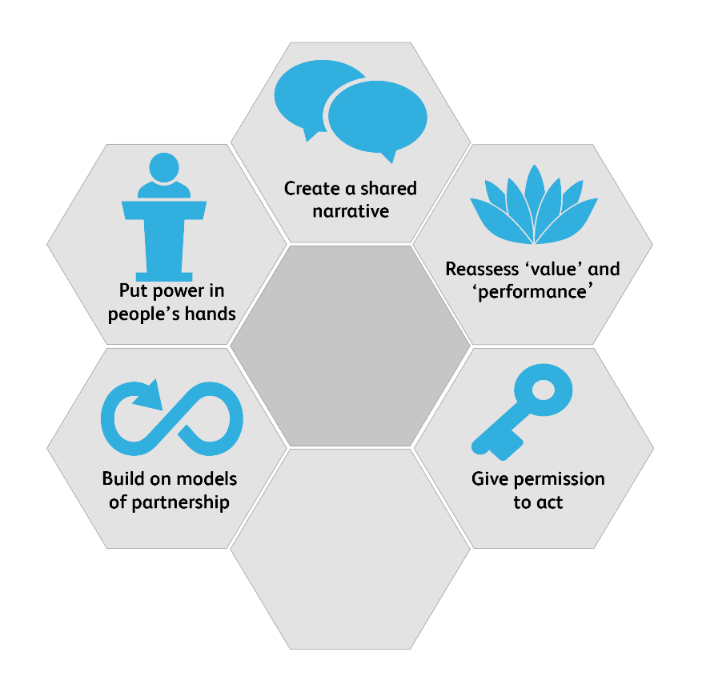Putting kindness at the heart of community planning
There is a raft of evidence on the importance of social relationships, and increasingly on the positive effect of kindness, in and of itself. So many of the stories we have told over the last six months – of communities ‘pulling together’, and neighbours offering a helping hand – have centred on a shared humanity and spirit of kindness. As we experience another national lockdown, these values and behaviours are as important as ever.
Using kindness to reframe a community’s outcomes
Yet, often, these conversations focus on the individual. What would it look like if we were to embed kindness in our organisations and in the way that we deliver public services? And what is the role of community planning in creating the conditions for social connection and relationships to flourish?
For the past two and a half years, the Carnegie UK Trust has been working with North Ayrshire Council to explore some of these questions. By embracing kindness as a value, the local authority and its partners have aimed to reframe their relationship with communities and improve outcomes in tackling poverty and inequality. The journey so far – its achievements, challenges, and opportunities for the future – is documented in a new report, North Ayrshire: A case study on kindness.
Embedding kindness in community planning
Over the course of this work, we have learnt what can be achieved by creating space for a conversation about values. In North Ayrshire, the language of kindness is embedded in policy and collective vision, most explicitly in a Kindness Promise that has been endorsed by chief officers across the Community Planning Partnership; and there is a sense that this visibility has precipitated a shift in attitudes and behaviours.
North Ayrshire ‘Kindness Promise’
We will strive to create the conditions for kindness in our organisations and for the people we serve by:
- trusting our staff to make meaningful connections with people
- protecting time and creating spaces for people to come together
- listening to people’s needs and finding solutions in the round, not just addressing our bit of the
picture - creating opportunities to recognise and celebrate kindness
- creating a culture where people are more important than processes and enabling unkindness
to be called out - ensuring our performance management aligns with our values and committing to ask our staff
and those we serve if they experience kindness
Alongside this, the partnership has recognised the necessity of making significant organisational change, in order to reduce the barriers to kindness. We heard that, too often, staff are inhibited by unhelpful targets and regulations, which make it difficult to act in kindness; and we heard how organisational priorities can get in the way of a joined-up, holistic approach to supporting individuals and communities.
Covid-19 response created space for change
These structural barriers are embedded in organisational approaches to risk, performance management and professionalism. But in responding to the Covid crisis over the last six months, we have seen what can be achieved when they are overcome:
- In North Ayrshire, the suspension of targets allowed services to focus on outcomes, and flexibility in budgets empowered staff to deliver them.
- A unifying sense of common purpose and relaxation of governance facilitated more effective partnership working, particularly with the voluntary sector and communities who emerged as equal partners.
- And, above all, a transformed approach towards risk and accountability shifted autonomy and decision-making responsibility to those that had the closest relationships with people and communities.
These changes, underpinned by kindness and indeed embodying the principles set out in the Kindness Promise, present a real opportunity to sustain and develop what has been possible during Covid. The learning from our ‘Covid conversations’ over the past 6 months highlights five key priorities for embedding radical kindness across North Ayrshire.

We have seen the power of a shared narrative that tells a story about kindness as a common value; and this comes to life when organisations put power in people’s hands and give communities the tools and resources to take control. Within organisations and services, people need permission to act: the trust and autonomy to make connections with people and respond accordingly. But this can only happen if we reassess ‘value’ and ‘performance’, and ensure that approaches to targets and risk allow the space for kindness and relationships.
The final priority looked at models of partnership and new ways of working together. In North Ayrshire, community hubs brought together local partners ‘under one roof’, facilitating collaboration and enabling a more flexible and responsive approach to supporting people. These themes of collaboration, sharing power – and indeed kindness – have been reflected and reinforced in conversations with communities across the UK. And in these stories and experiences, some of which we have brought together in a new report, COVID-19 and Communities Listening Project: A Shared Response, there might just be a framework for building community wellbeing beyond the pandemic.
Although the immediate future appears challenging and uncertain, the pandemic has shown what can be achieved when we act out of “love, kindness and solidarity”. Our learning has been that these values are as important for our institutions as they are in our individual lives, and we look forward to continuing the conversation about how we can unlock radical kindness within our organisations, and create systems and structures that support communities to thrive.
People, places, and connection
Have a look at our evidence review into what makes the places we live, work and meet up in better places for our wellbeing.
